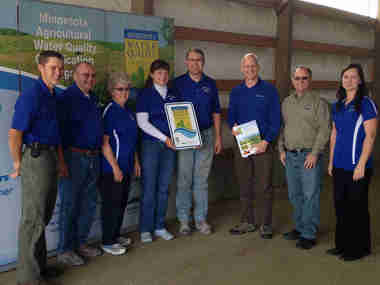
The National Association of State Departments of Agriculture will be presenting its first public-private partnership award next week in Hartford, CT to the Minnesota Dept. of Agriculture's Agricultural Water Quality Certification Program and Land O’Lakes. The public-private partnership was established in 2016 with the shared goal of protecting and improving water quality in Minnesota.
Certification is a voluntary opportunity for farmers and agricultural landowners to
take the lead in implementing conservation practices that protect our water. It uses a risk-assessment process where risks to water quality
are identified and treated. When an identified risk is mitigated it is counted
as a new practice. Farms that install and maintain approved farm management
practices will be certified and in turn obtain regulatory certainty for a
period of ten years. Photo: Certification presentation at Dorrich Dairy east of Glenwood (L-R): Greg Vold, Richard Vold,
Dorothy Vold, Suzanne Vold, Brad Vold, of Dorrich Dairy; Brad Jordahl Redlin,
Grant Pearson,
of MAWQCP; Holly Kovarik, Pope
SWCD.
To date, 74 of Minnesota's 87 counties have at
least one water-quality certified farm. Certification numbers as of Sept. 6:
- 635 certified producers
- 397, 595 certified acres
- 1,214 new practices implemented
Impact on water quality:
- 21,474 tons of soil saved per year
- 57, 542 tons of sediment reduced per year
- 25,194 lbs. of phosphorus prevented per year
- Up to 49% estimated reduction in nitrogen loss
The purpose of the NASDA Public-Private Partnership Award is
to recognize National
Association of State Departments of Agriculture (NASDA) Partners Program
organizations that have partnered with a state to implement a program, project,
or service that positively impacts the state. The collaboration with Land O’Lakes, Inc. provides the opportunity
for the state to develop delivery of conservation services via
private industry, with the potential to take resource stewardship to a greater
scale.
Back to top
|
 Farmers in the Cedar River Watershed gathered Aug. 17 at the Justin Krell farm to learn from local experts how maximizing soil health can economically benefit their operations while protecting water quality. The Cedar River Watershed Partnership organized the event for dozens of farmers in the watershed and surrounding region at the Krell farm near Blooming Prairie, the upper part of the Cedar River Watershed. CRWP photo: Justin Krell speaking to group.
Aimed at increasing farmers’ knowledge of soil health practices, particularly tillage and cover crops, the field day focused on the costs and benefits of adopting different land-management practices that improve the soil, water and economic health of farms. Local agricultural retailer Central Farm Service (CFS) provided a field demonstration to showcase different tillage methods and the associated profitability, yield, and soil health. Keynote speakers included Bert Strayer, a cover crop expert with La Crosse Seed who shared his deep experience of integrating cover crops into a profitable farm management strategy, and Steve Lawler, a soil scientist with Mower County Soil & Water Conservation District (Mower SWCD) who demonstrated how healthy soil can help with water retention and mitigate intense rain events.
The partnership shared with farmers how to increase agricultural productivity and profit while also protecting and improving local water resources through a panel discussion moderated by Hormel Foods. Partners encouraged farmers in the watershed to contact and work with partners like CFS, the Mower SWCD, and Land O’Lakes SUSTAIN to pursue information, services and resources that help them adopt practices that are the most effective and practical for their operation. - CRWD news release.
Back to top
|
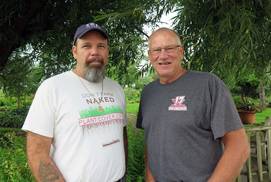 August is the busy season for shrimpers along the Gulf Coast, and fishermen like Randy Skinner and Lance Nacio should be heading out in their trawlers to try to haul in a day's catch.
But instead, recently Skinner and Nacio traveled more than 1,000 miles north to central Minnesota to share stories about how what happens along the Mississippi River is affecting their livelihood.
Every year, a dead zone about the size of Connecticut forms in the Gulf of Mexico. It's caused by excess nutrients washing down the Mississippi River — and it has a major impact not only on fish and marine life, but on the people who earn their living on the Gulf.
Local clean water advocates invited Skinner and Nacio to the Brainerd area to talk about that impact. The pair toured a ranch near Staples, Minn., that uses sustainable farming practices and spoke at a harvest dinner with local farmers at Sunup Ranch near Brainerd. Photo by Kirsti Marohn: Lance Nacio, left, and Randy Skinner. Full story on MPR.
Back to top
|
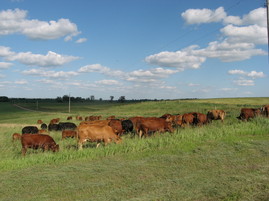 By Jenny Schlecht, AgWeek, 8/20/18: Often the focus of attention for their conservation practices at their Stoney Creek Farm in Redwood County, Grant and Dawn Breitkreutz recently hosted a Soil Health Academy July 31-Aug. 2. Stoney Creek Farm is 100 percent no-till on every crop and grows cover crops during or after every crop to keep living roots in the soil at all times. Cattle are cell-grazed across every acre to ensure they "get a hoof print across every inch," Grant says.
Soil Health Consultants LLC partners, Allen Williams, Gabe Brown, Ray Archuleta and David Brandt, all came to the farm northwest of Redwood Falls for the event, along with participants from seven states and one Canadian province, ranging from college students to active and retired farmers and university professors.
The workshop addressed how improved soil health can affect such issues as profitability, the impact of droughts or floods, water quality and fertilizer inputs, and provided instruction on things like increasing organic matter, implementing integrated pest management strategies, designing cover crop mixes and integrating livestock into cropping systems.
The Breitkreutzes are striving to quit using commercial fertilizers. They now use .2 pounds of nitrogen to produce each bushel of corn, and they have maintained an actual production history of 190 bushels per acre. It costs them $2.59 to produce each bushel of corn, which means even the relatively low local corn price of $3.21 per bushel turns a profit. Additionally, they have seen higher percentages of protein in their corn and other feeds, which has helped when they run it through their livestock. Full story in AgWeek.
Back to top
|
|
With just enough rain since they were planted Aug. 2, about 36 varieties of cover crops were emerging in a long row of small plots at a "soil health tour" Aug. 29 in Stearns County. Viewing the plots across Hwy. 15 from Luxemburg Feed Service, farmers and agency staff listened as Rick Tamm of Byron Seeds described the varieties and what they can do, from tilling soil, fixing nitrogen, scavenging nitrogen, ground cover, livestock forage, and building soil organic matter.
The plots wrapped up a day-long tour that included cover crops at the Lee Zabinski farm, no-till at Bechthold Dairy, Alan Olmscheid's hayable buffers, and Francis Krippner's rock-surfaced stream crossing. When considering cover crops, Tamm advised farmers to first determine the goal before choosing what type to use. Tour sponsors included: Stearns SWCD, Sauk River Watershed District, and NRCS.
Back to top
|
|
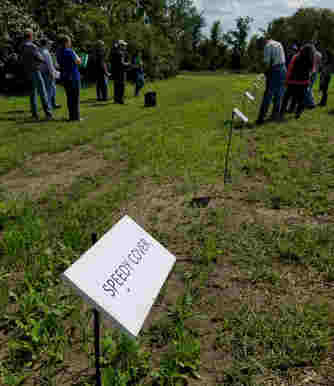 |
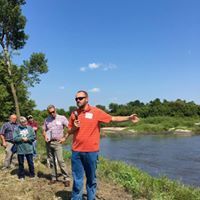
Exploring the unique opportunities and
challenges facing southwest Minnesota, the Minnesota Board of Water and Soil
Resources (BWSR) gathered local, state, and federal conservation staff for its
annual board tour Aug. 22 in Rock and Nobles counties. The board visited a number of projects
focused on flood recovery and water quality improvements.
Tour stops included
wellhead areas in Worthington and Adrian, the recently-restored Summit Lake in
Nobles County, and a presentation in Luverne highlighting disaster recovery
efforts following significant flooding in 2014. Local partners included the
Okabena-Ocheda Watershed District, the Rock County SWCD, the Nobles County
SWCD, the Minnesota Rural Water Association, and the Rock County Rural Water
District.
The 20-member BWSR board includes
representatives from state agencies, local governments, and citizens. Board
tour destinations rotate each year to highlight different regions of Minnesota.
The projects featured during the annual tour illustrate how successful
partnerships between federal, state, and local governments and private
landowners safeguard and enhance Minnesota’s soil and water resources. Photos from the Board Tour can be found on
Facebook here: https://goo.gl/XjgnyC. - BWSR news release, Aug. 23.
Back to top
|
BWSR news release, Aug. 27: Continuing statewide work to shift local
water planning to a more coordinated approach, the Minnesota Board of Water and
Soil Resources (BWSR) approved nine new planning grants for the One
Watershed, One Plan program. The Aug. 23 board action
allocates up to $2.2 million in Clean Water Fund grants to fund nine planning
projects to address water issues on a watershed basis.
In the One Watershed, One Plan
Program, local governments combine information from their existing water plans,
data and information from state water agencies, and input from federal
agencies, nonprofit organizations, and citizen stakeholders. The resulting
plans identify actions that address the largest threats and provide the
greatest environmental benefits to high-priority water resources. Key to the
process is the partnership between counties, soil and water conservation
districts, watershed districts, and other stakeholders to identify and then
implement shared priorities and goals.
BWSR has divided Minnesota into 63 suggested
“planning boundaries” based on major watersheds. The legislature set
a participation goal in 2015 of all planning boundaries by the year 2025. So
far, the five pilot plans have been approved by the BWSR board and thirteen
groups are actively developing plans. The new planning grants bring the
number of planning partnerships to 27.
The nine new planning areas are:
-
Hawk Creek watershed, which
includes parts of Chippewa, Kandiyohi, and Renville counties.
-
Joe River and Two Rivers watershed, which
includes parts of Kittson and Roseau counties
-
Mississippi River Headwaters
watershed, which includes parts of Beltrami, Cass, Clearwater,
Hubbard, and Itasca counties.
-
Nemadji watershed, which
includes parts of Carlton and Pine counties.
-
Redeye River watershed, which
includes parts of Becker, Otter Tail, Todd, and Wadena counties.
-
Rum River watershed, which
includes parts of Aitkin, Anoka, Benton, Crow Wing, Isanti, Kanabec Mille Lacs,
Morrison, and Sherburne counties.
-
Shell Rock River and Winnebago
watershed, which includes part of Freeborn County.
-
Wild Rice and Marsh River watershed,
which
includes parts of Becker, Clay, Clearwater, Mahnomen, and Norman counties.
-
Zumbro River watershed, which
includes parts of Dodge, Goodhue, Olmsted, Rice, and Wabasha counties.
More information about the One Watershed One
Plan program, including a map of the participating watersheds, is on
BWSR’s website: www.bwsr.state.mn.us.
Back to top
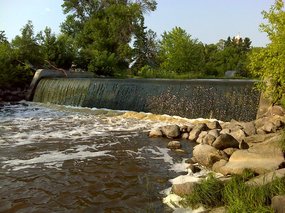
Implementing
voluntary land use management practices would reduce water pollution in the Lower Red River
Watershed according to two draft studies by the Minnesota Pollution
Control Agency (MPCA) and local watershed partners. The MPCA invites comments
on the studies through Sept. 12. Photo: Dam on the Tamarac River.
Local
partners include the Kittson, Marshall, and Roseau Soil and Water Conservation
Districts and the Two Rivers, Joe River, and Middle-Snake-Tamarac Rivers
Watershed Districts.
Excessive
levels of bacteria, sediment, a pesticide called chlorpyrifos, and chloride,
along with stressors causing poor fish and aquatic insect communities,
contribute to impairments in this northwest Minnesota watershed. The stressors
that negatively impact some fish and aquatic insect communities include
barriers to fish passage, altered stream flows, lack of physical habitat, high
levels of suspended sediment, and low dissolved oxygen.
To bring about significant water quality improvement, the
studies recommend widespread changes in land use and agricultural practices.
These voluntary actions, coupled with increased public understanding and
support, need to occur because the vast majority of land is privately owned and
used for agriculture. While landowners in the Lower Red River Watershed have
long been engaged in good land stewardship practices, the MPCA and its partners
recommend they continue to build upon best management practices known to
improve water quality.
Open for
comment are the Total Maximum
Daily Load (TMDL) study and the Watershed
Restoration and Protection Strategies (WRAPS) report. They are
companion documents that quantify pollutant levels, identify pollution sources,
propose ways to return water quality to an acceptable level and describe
protection strategies to ensure continued high quality water resources.
Comments on the draft reports should be sent to Danielle
Kvasager, 714 Lake Avenue, Suite 220, Detroit Lakes, Minnesota 56501; or by
email, danielle.kvasager@state.mn.us.
For more information, call her at 218-846-8117. Comments must be received by
4:30 p.m. on Sept. 12.
Written comments must
include a statement of your interest in the report (specify which report, WRAPS
or TMDL), a statement of the action you wish the MPCA to take, including
specific references to sections of the draft report you believe should be
changed, and specific reasons for your position.
Back to top
|
 Pepin leaves Extension for independent consulting
After more than 11 years working in livestock and manure management, Randy Pepin is leaving U of M Extension to become an independent consultant. According to an article in the Morrison County Record, the grant funding the Extension post was not renewed. For the last four months he worked as an interim extension educator, filling the position Crops Extension Educator Dan Martens left when he retired March 28. Although Pepin had the opportunity to apply for the position, he opted out. He will be working in Morrison, Todd, Benton and Stearns counties, and can be reached at (320) 333-1369. Services will include manure management plans, nutrient management, and record-keeping.
Discovery Farms research webinars available online
A series of free webinars have been offered live on the WaterWay Network to share the latest research from the Discovery Farms programs of Wisconsin and Minnesota. The first occurred Aug. 21, Edge-of-field water quality in two Wisconsin watersheds with Amber Radatz, UW Discovery Farms co-director. Following were: Aug. 28: Benchmarking Nitrogen Use Efficiency, Matt Ruark, UW-Madison Dept. of Soil Science; Abby Augarten, UW Discovery Farms NUE coordinator; and Sept. 4: Lessons learned from Spring Creek Farms, Tim Radatz, director, Discovery Farms Minnesota. Recordings of the webinars are available online. For more information contact Erica.olson@ces.uwex.edu.
Funding available for sustainable agriculture projects
The Minnesota Dept. of Agriculture (MDA) is
currently accepting applications for Agricultural Growth, Research and
Innovation Sustainable Agriculture and Demonstration Grants.
Focusing on the rural landscape, farmers and their families, this grant
provides funding for projects that explore new ways of conserving natural resources,
enhancing farm profitability, increasing energy efficiency, and improving life
in rural communities. In the past, SAD grants have funded a wide range of projects; such
as exploring farm diversification, cover crops and crop rotation, conservation
tillage, and input reduction strategies and alternative energies like wind,
methane, and biomass. Projects are published annually in the MDA’s Greenbook,
which provides a summary of each project along with results, management tips,
and other resources. Projects last two to three years and may be
funded at up to $50,000. Grant applications are due by 4:00 p.m. on Wednesday,
December 12, 2018. For more information and to apply, visit with www.mda.state.mn.us/sustagdemogrant. - MDA news release, 9/5/18.
Producers
still needed for pig environmental footprint project
University of Minnesota Extension is still looking for pork producers to participate in the Pig Environmental Footprint Project. Extension specialist, Erin Cortus and Extension
Educators, Diane DeWitte, Jason Ertl, and Sarah Schieck will work with pork
producers in confidentially assessing their own operations using the Pig
Production Environmental Footprint Calculator - a tool developed with support
from and maintained by the National Pork Board. The goals are to assess the range of footprints for regional pig production systems, identify opportunities to improve efficiencies as we look toward the future, and better understand how producers can utilize this tool on their operations. Read more.
Read
more.
Back to top
|
Newburg Township board approves year-long feedlot moratorium
Rochester Post-Bulletin, 8/24/18
Respect going both ways: Film brings large-, small-scale farmers together
MPR, 8/17/18
DNR gathers data on water cycle in Bonanza Valley
West Central Tribune, 8/27/18
In Minn., Gulf shrimpers meet farmers trying to save their catch
MPR, 8/28/18
Minnesota ranch looks to regenerate land rather than sustain it
AgWeek, 8/20/18
Environmentally friendly farming practices used by nearly one third of world's farms
Science Daily, 8/27/18
Here's how America uses its land
Bloomberg, 7/31/18
Air tests at hog farm again show safe air
Rochester Post-Bulletin, 9/4/18
Record number of comments delay decision on proposed Fillmore County hog farm
MPR, 9/5/18
Back to top
Sept. 13: Open house, U of M SROC, Waseca.
Sept. 14: Reduced tillage and cover crops field day, 8:30-12:30, Hawk Creek Watershed Project/Renville County SWCD, Renville Community Center.
Sept. 19-20: Minnesota livestock nutrition conference, Verizon Center, Mankato
Nov. 27-29: Minnesota Dairy Expo, Treasure Island Resort and Casino, Welch.
Dec. 9-11: Minnesota Association of SWCDs convention, DoubleTree, Bloomington.
Back to top
The
MPCA Feedlot Update welcomes news from partners about, projects, people, and
upcoming events. Email submissions to forrest.peterson@state.mn.us.
Past issues of Feedlot Update are available on the feedlot program publications webpage.
|